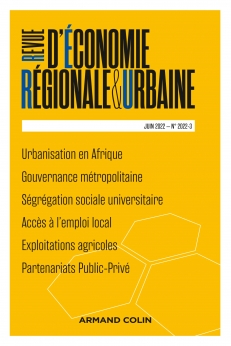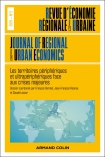
REVUE D'ÉCONOMIE RÉGIONALE ET URBAINE (3/2022)
Pour acheter ce numéro, contactez-nous
Recevez les numéros de l'année en cours et accédez à l'intégralité des articles en ligne.
Cette étude exploite le premier test de discrimination sur le marché du travail réalisé à l’échelle de l’ensemble des entreprises d’un territoire fin : l’Avesnois, qui correspond à un arrondissement administratif de 230 000 habitants. Nous exploitons les résultats d’un test de correspondance mené sur un échantillon de près de 1 000 entreprises, tirées au sort au sein d’un ensemble de 9 000 unités légales, auxquelles nous avons proposé un couple de candidatures au début du mois d’octobre 2020. Sur ce territoire particulier et dans le contexte exceptionnel d’une situation économique très déprimée, nous ne détectons pas de discrimination selon l’origine aux seuils usuels de significativité statistique, mais nous détectons un effet de stigmate associé à un lieu de résidence dans un quartier prioritaire de la politique de la ville. Cet effet de discrimination résidentielle n’existe que pour les hommes. La pénalité induite par le lieu de résidence est donc sensible au genre.
Most discrimination tests are conducted on a regional or national scale. However, local labor market situations are very different from one city to another, in terms of the socio-demographic composition of job seekers, the structure of the productive fabric and the degree of local tension between labor supply and demand. This study exploits the first labor market discrimination test conducted on the scale of all firms in a thin territory in northern France: the Avesnois, which corresponds to an administrative district of 230,000 inhabitants. We use the results of a matching test conducted on a sample of nearly 1,000 firms, drawn at random from a set of 9,000 legal units. At the beginning of October 2020, we sent 2,000 unsolicited applications to these employers, making it possible to measure discrimination on the basis of presumed North African origin and residence in a priority district (with a high poverty rate), for both men and women. The results are original and unexpected. In this territory and in the exceptional context of a strong economic depression, between the two confinements imposed in reaction to the health crisis, we do not detect discrimination according to origin at the usual thresholds of statistical significance, but we do detect a stigma effect associated with a place of residence in a priority district of the city policy. This residential discrimination effect exists only for men and reduces their chances of getting a job interview by 65%. The difference in response rate between a woman residing in a City policy Priority District (CPD) and a woman residing in a neutral neighbourhood is not significant. The penalty induced by the place of residence is therefore gender sensitive.

